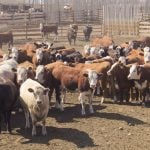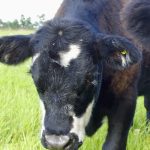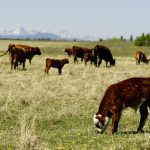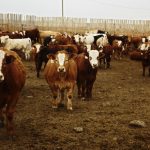
Animal health

Rethinking transition diets for finishing cattle
Feed additive shows promise for accelerating dietary transitions in feedlot cattle
Among the most prevalent diseases in feedlot cattle, ruminal acidosis ranks second only to respiratory diseases in contributing to morbidity, mortality and economic losses. Given its effect on animal welfare and profitability, preventing acidosis remains a key focus in feedlot cattle research. In this month’s column, we want to discuss the role of transition diets […] Read more

IBR is a serious cause of abortion in beef cattle
Veterinary Case Study: After buying new stock, a rancher’s cow herd starts aborting third-trimester calves
Early one morning in January, Alf called upset over what he found when checking his herd of purebred Herefords. Lying in the straw were three aborted fetuses and two other cows appeared to be in the process of aborting third-trimester fetuses. Alf, an excellent stockman but very worried, asked the hard question of what might […] Read more

Passing the presidential baton
CCA Reports, from the April 2025 issue of Canadian Cattlemen
As I write this message, my time as president is rapidly coming to an end. I am thankful for my family’s support at home and the support of so many crews that let the Canadian Cattle Association’s (CCA) elected leadership take time away to serve the industry beyond the home operation. Our voice as cattle […] Read more

Preparing for calving season
Veterinary Case Study: Dr. Clarke coaches a beef producer who has purchased 50 first-calf heifers right before calving season
Jim came into the clinic one day. He’d even called ahead to say he needed a few minutes of my time to talk about the 50 new heifers he bought and what they might need to help them through calving season without problems. Jim had become an astute cattleman through the years, always trying to […] Read more

Reducing disease risk from calving season onwards
Whether it’s scours or Johne’s disease, farmers and ranchers can reduce the chance of transmitting it
With winter calving almost at a close, grassland producers are preparing for their own spring calving season. Chad Ross calves his herd of 800 to 1,100 cows as close to nature as he can. The owner and operator of L-7 Land and Cattle at Estevan, Sask., switched to grassland calving in the mid-2000s. Unless a […] Read more

Causes and risk factors of abortion in cattle
Vet Advice with Dr. Ron Clarke
When examining abortion in cattle, it’s important to look at incidence, cause, definition, when to summon help and what to do. As an aid to producers, abortion can be defined as terminating pregnancy any time after around 42 days, when placentation is complete. Placentation is the establishment of membranes joining mother and fetal blood supply […] Read more

Flexibility key to surviving drought
Long-time rancher discusses how he adjusts his grazing and feeding plans based on conditions
Grazing and its likely availability is at the heart of every management decision at Jim and Barb Bauer’s Anchor J Ranch near Acme, in central Alberta. Even after 40 years of grazing on that land Jim still makes a grazing plan, usually in February. “I don’t want two groups of cattle sharing a dugout,” he […] Read more

DNA samples at calving could be new norm
Alberta cattle producer says it’s time for the beef industry to catch up
For seed stock producers, taking DNA samples from newborn calves is becoming more common. Most seed stock herds calve in the winter when the temperature can dip to around -30 C or beyond, snow sparkling under a harsh winter sun. At that time of year, there is already so much to do, and adding another […] Read more

Cattle growth-enhancing technologies: A win-win for beef producers and consumers
As we approach the end of the fall calf run, feedlots are working diligently to get new calves on full feed as quickly as possible. This fall brought above-average temperatures and fewer storms, making it easier for feedlots to get calves settled and eating well. With calf prices at record highs, these calves must grow […] Read more

Biosecurity on beef cattle operations
Vet Advice with Dr. Ron Clarke
The term “biosecurity” is used throughout all aspects of food production, from growing food to moving commodities between different sectors, placement on grocery shelves and finally consumption and waste management. They are all related and all have their biosecurity plans. Those plans seldom account for what comes before and what follows. For the livestock industry, […] Read more



